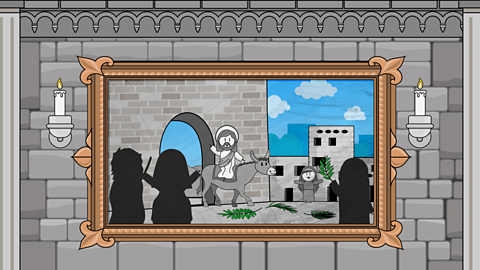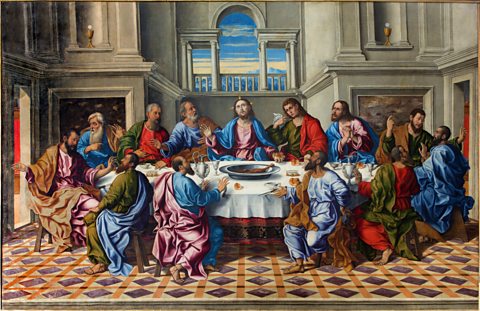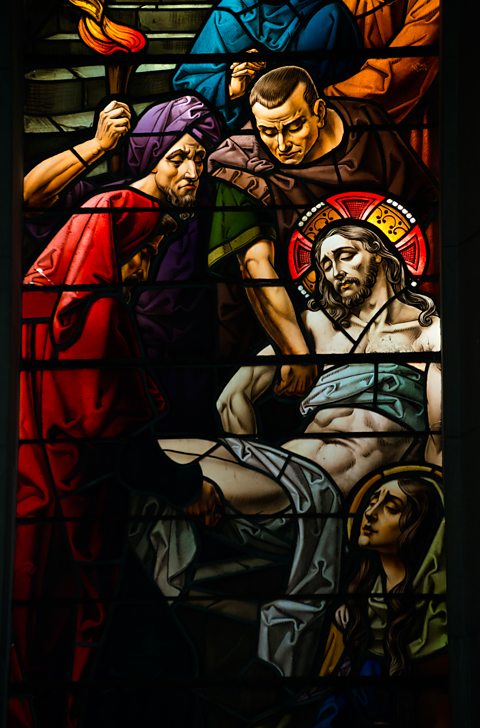Palm Sunday

Palm Sunday is the first day of Holy WeekHoly Week marks out the events of the last seven days of Jesus’ life. celebrating Jesus' entry into Jerusalem on a donkey. It is celebrated each year the Sunday before Easter Sunday.
These events were recorded by eye-witnesses Matthew and Luke, two of the GospelThe four Gospels in the Bible - Matthew, Mark, Luke and John - are in the New Testament. They tell of the life, ministry and death of Jesus. writers.
Crowds of people came out of the city to greet Jesus throwing down palm branches on the road as he passed.
Some Anglican and Roman Catholic churches give out small crosses made from palm leaves, as a reminder of Jesus's entrance into Jerusalem and his death on the cross.

The Last Supper
The Last Supper was the final meal Jesus shared with his disciples, the night before his crucifixion, on what is remembered as Maundy Thursday.
During the meal Jesus did three notable things:
- He predicted one of his disciples would betray him.
- He broke bread and shared it with his disciples, saying. “This is my body given for you; do this in remembrance of me.” (Luke 22:19)
- He offered wine to his disciples, saying, “Drink from it, all of you. This is my blood of the covenant, which is poured out for many for the forgiveness of sins.” (Matthew 26:27-28)
The Last Supper holds special significance for Christians as it forms the basis of the EucharistThe Christian service, ceremony, or sacrament commemorating the Last Supper. / communion.

The betrayal and arrest
After the Last Supper Jesus went with some of his disciples to the Garden of GethsemaneGethsemane is a garden at the foot of the Mount of Olives in East Jerusalem where, according to the four Gospels, Jesus underwent agony in the garden and was arrested before his crucifixion..
As previously predicted by Jesus, one of his disciples - Judas, arrived leading the chief priests and their guards to Jesus.
The disciples wanted to defend their leader. Peter, Jesus’ closest disciple, cut off the ear of the High Priest’s servant.
Jesus healed it and ordered that there should be no violence. He told them to put their swords away.
Jesus was led away to the house of the High Priest.
The trial

- Jesus was put on trial by the SanhedrinThe Sanhedrin was the supreme council and tribunal of the Jews at that time headed by a High Priest and having religious, civil, and criminal jurisdiction..
- His claim to be the Son of God was considered BlasphemyThe action or offence of speaking sacrilegiously about God or sacred things...
- They found him guilty of this charge.
- The next morning Jesus was taken to the Roman governor, Pontius Pilate.
- Pilate’s wife had a dream telling her that Jesus was innocent, she sent a message to her husband to tell him.
- Pilate tried to avoid sentencing Jesus because of his wife’s message.
- It was a PassoverPassover is a celebration of the story of Exodus. During Passover, Jews remember how their ancestors left slavery behind them when they were led out of Egypt by Moses. custom for a prisoner, chosen by the people, to be released.
- Pilate attempted to use this custom by offering the assembled crowd a choice: release Jesus or Barabbas, a notorious prisoner.
- The crowd chose to have Barabbas released.
- This meant Jesus was to be crucified.
- Pilate attempted to ask the crowd what crime Jesus had committed, but they shouted, “Crucify him!”
- Pilate publicly washed his hands to show that Jesus’ death was not his responsibility.

The crucifixion of Jesus

After being sentenced Jesus was whipped and stripped of his clothes. He was given a crown of thorns and a robe to wear whilst the crowds mocked him.
As was custom, he had to carry his cross to Golgotha where he was to be crucified. He fell three times on the path. A man called Simon from Cyrene was forced to help him carry the cross.
At Golgotha his clothing was split amongst the guards.
He was crucified between two criminals with a sign reading, ‘The king of the Jews,’ placed above his head.
At noon the sky went dark and three hours later Jesus cried out, "Eli, Eli, lama sabachthani?", which means, "My God, my God, why have you forsakenTo be abandoned or deserted. me?" (Matthew 27:46), he took his final breath and died.
At that moment, the veil in the temple tore in two and the Earth shook.
Jesus’ crucifixion is marked every year on Good Friday.

The resurrection of Jesus
On the Sunday morning, Luke’s GospelThe four Gospels in the Bible - Matthew, Mark, Luke and John - are in the New Testament. They tell of the life, ministry and death of Jesus. says that some women went to visit the tomb of Jesus to anoint his body.
When they arrived, they found the stone covering the tomb rolled away. Two men in bright shining clothes appeared to them asking:
“Why are you looking among the dead for one who is alive? He is not here; he has been raised.” (Luke 24:5)
| Key points of the resurrection: |
| The tomb was empty, the grave clothes had not been disturbed, and the body had gone |
| Neither the Jewish authorities nor the Roman authorities had any idea where the body had gone |
What happened to the body?
Christian responses to conspiracy theories:
| Jesus wasn’t really dead | The soldiers would have made sure that a prisoner was dead before taking them off the cross. There is historical evidence that the soldier in charge risked death himself if the job was not carried out properly. |
| The women went to the wrong tomb | We are told the women witnessed the body going into the tomb so they would know which one to go to again. The Jewish officials would have been able to point out the right tomb and produce the body. The Burial clothes were found in the tomb. |
| The authorities stole the body | If the authorities had removed the body, they would have produced it later to prove the disciples wrong when they claimed that Jesus had risen from the dead. |
| The disciples stole the body | How would they have got past the guards who were stationed at the entrance to the tomb? Why would the disciples have been prepared to be martyred for a lie that they had created themselves? |
The ascension
After Jesus’ ResurrectionThe Christian belief that Jesus rose from the dead on the third day after the crucifixion. The rising from the dead of believers on the Last Day in a new, or risen, life. he spent time with the disciples. He commissioned them out to tell people about him and his teaching and said God would send the Holy Spirit to help them.
One day he led them out to Bethany, outside of the city and blessed them.
Then he was taken in a cloud up into heaven. Two men appeared clothed in white robes and asked why the disciples were watching the heavens. They said:
“Jesus has been taken from you into heaven, but someday he will return from heaven in the same way you saw him go!” Acts 1:11
The ascension shows Jesus returning to his Father, and later at PentecostPentecost was an important Jewish festival which celebrated the harvest. Often Jews would travel to Jerusalem to celebrate in the capital city. Pentecost was celebrated fifty days after the Passover. the Holy Spirit descended on the apostles, just as Jesus had promised.
What does the resurrection mean for Christians?
- Jesus is alive, not dead.
- It confirms that Jesus’ teaching was true, he was the Son of God.
- It fulfils the prophecy that the Son of Man would rise again.
- It confirms that life triumphs over death. Good triumphs over evil.
- It provides hope that nothing can separate them from God’s love.
- It provides comfort when facing death or grieving a loved one that death is not the end and there is an afterlife with God in heaven.
- It demonstrates God’s power; if he raised Jesus from the dead then he can do anything. This provides comfort especially in times of difficulty.
Order it!
More on Revelation of God
Find out more by working through a topic
- count1 of 12

- count2 of 12

- count3 of 12

- count4 of 12
